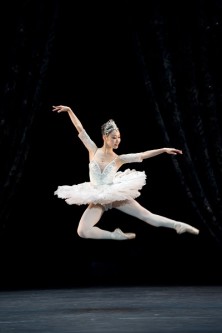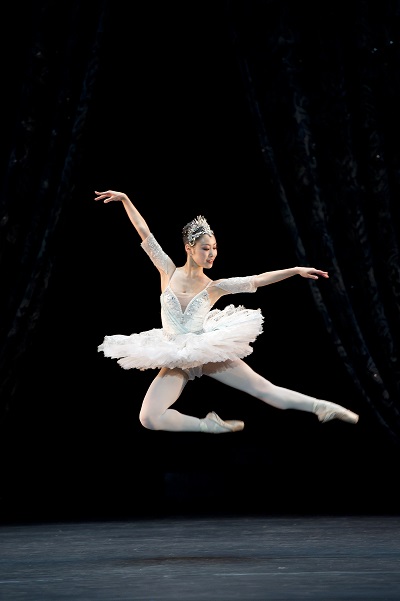 United Kingdom Tchaikovsky, Kline & Elgar – A Triple Bill from Birmingham Royal Ballet: Dancers of Birmingham Royal Ballet, Royal Ballet Sinfonia, Paul Murphy & Philip Ellis (conductors), Birmingham Hippodrome, Birmingham, 28.9.2015 (GR)
United Kingdom Tchaikovsky, Kline & Elgar – A Triple Bill from Birmingham Royal Ballet: Dancers of Birmingham Royal Ballet, Royal Ballet Sinfonia, Paul Murphy & Philip Ellis (conductors), Birmingham Hippodrome, Birmingham, 28.9.2015 (GR)

Tchaikovsky: Theme and Variations
Dancers:
Principal Woman: Momoko Hirata
Principal Man: Joseph Caley
Main Support: Samara Downs, Céline Gittins, Yvette Knight, Delia Matthews, Yasuo Atsuji, William Bracewell, Brandon Lawrence, Feargus Campbell
Production:
Choreography: George Balanchine
Designs: Peter Farmer
Lighting: John B. Read
Staged by Desmond Kelly
Conductor: Paul Murphy
Phil Kline: Kin.
Dancers:
Principal Couple: Elisha Willis and Joseph Caley
Supporting Four Couples: Laura Day, Samara Downs, Delia Matthews, Yijing Zhang William Bracewell, Tzu-Chao Chou, Brandon Lawrence, Max Maslem
Production
Choreography: Alexander Whitley
Designs: Jean-Marc Puissant
Lighting: Peter Teigen
Conductor: Philip Ellis
Elgar: Enigma Variations
Dancers:
Edward Elgar: Jonathan Payn
The Lady: Samara Downs
Hew David Stewart Powell: Kit Holder
Richard Baxter Townshend: Feargus Campbell
William Meath Baker: Rory Mackay
Richard P. Arnold: Jamie Bond
Isabel Fitton (Ysabel): Arancha Baselga
Arthur Troyte Griffith: César Morales
Winifred Norbury: Angela Paul
AJ Jaeger (Nimrod): Valentin Olovyannikov
Dora Penny (Dorabella): Elisha Willis
George Robinson Sinclair: Tzu-Chao Chou
Basil G Nevinson: Dominic Antonucci
Lady Mary Lygon: Yijing Zhang
Production
Choreography: Frederick Ashton
Designs: Julia Trevelyan-Oman
Lighting: Mark Jonathan
Conductor: Paul Murphy
After Stravinsky choreographer George Balanchine had an affinity for Tchaikovsky and he epitomised the St Petersburg dance style in many of his productions, including Theme and Variations. It opens the current Triple Bill from Birmingham Royal Ballet, the second presentation of their 2015-16 season and the twenty-fifth at their Birmingham Hippodrome home. Although not originally composed as a ballet, the Tema con variazioni final section of Tchaikovsky’s Suite No. 3, like so much of his music, makes for wonderful dance; the performance of BRB on Oct 8th is witness to that. Although narrative is non-existent, the twenty-four minutes are intimately linked by the modest initial theme and its twelve distinct variations. Indeed the Royal Ballet Sinfonia under conductor Paul Murphy excel themselves in the execution of Tchaikovsky’s music. The strings under leader Robert Gibbs securely lay the foundations with a definitive theme and opening two Andante con moto variations, the second notable for its pitter-patter accompaniment. The BRB corps of twelve provide a glittering spectacle on curtain-up. Variation II also sees the entry of Momoko Hirata as the Principal Woman (see photo) skilfully establishing a hierarchy among her entourage. Woodwind dominate III, as attention focuses on the flute of Sandra Skipper. IV sees a change to the minor key and a more animated mood as the full orchestra enter and the Principal Man of Joseph Caley takes charge. As the major key returns, the tempo increases to Allegro and VI is notable for its quaver triplets and the eight consecutive tours en l’air from Caley. The oboe of Alaster Bentley highlights the L’istesso tempo of VII as the corps gracefully weave in and out of one another. Further numbers from the soloists, the four featured couples and troupe occupy VII, VIII and IX. The violin solo from Gibbs is a perfect match to the solo of Hirata in X and her pas de deux with Caley in XI was gratifying. The brillante Polacca of XII is exuberant, the polonaise ending with Hirata triumphant upon Caley’s shoulder.
From the purely classical ballet of Balanchine and Tchaikovsky, BRB move to what is a blend of the traditional with contemporary – Kin – with choreography by BRB old-boy Alexander Whitley. Although the piece was premiered at the Birmingham Crescent last year and has been on tour, this is its first showing at the Hippodrome. There is a double meaning to the title, referring to both the family ‘kin’ and as an individualistic abbreviation for ‘kinetic energy’. The set design of Jean-Marc Puissant features three doors rear stage, representative of openings into domestic habitats, but being permanently shut I think they lose impact. Again the music plays a key role in the reception of this piece, a string quartet by American modernist Phil Kline. His score The Blue Room and Other Stories is in four movements, each with its distinct character and energy. The opening cello sound in the initial movement is so intense and mega-forte that it made me wonder if the live instrumentalists are amplified. Along with the half-light of Peter Teigen, it left me in a bit of a daze, in keeping with another of Kline’s compositions from 2009, Around the World in a Daze. Nevertheless this light and sound combination seemed the perfect complement to the athletic contortions of the black-leotard clad Elisha Willis, reaching, collapsing, and tying herself in knots, either as soloist or with partner Joseph Caley. Unable to shake off the nagging rhythm of music, Willis presents the notion of a lost soul, but with a floor exercise routine worthy of any Olympic finalist. Although this does not seem to entirely relate to Whitley’s concept of Kin, the following three sections do, I think, provide a good match. For example, the staccato effects of the quartet’s second movement are a foil for the movement of the supporting four couples (see photo), reminding me of perpetual motion. Theirs is an energy that cannot be destroyed and certainly is in kinetic form! The third movement seems to present the other side of Kin, that of relationships and the female dancers are now en pointe, exploring how by coming into contact they might relate with one another. Here there is a bounciness to Willis, her blond hair in unison with her hops and jumps, while during the lyrical pas de deux, she and Caley synthesise with the rubato tempo – the best part of Kline’s score. The busyness of Whitley’s choreography continues in the final movement, now with a semblance of order but still relentless, lively and rhythmical, including a fiery solo from Tzu-Chao Chou. The momentum of the group eventually evaporates, their dazzling kinetic energy transmogrifies into body heat. It’s an abstract piece, but Whitley has an eye for people lost to themselves. This is a great appetizer, so let’s have more from this young choreographer!
Since Sir Edward Elgar composed his Enigma Variations in 1899, there has been much speculation as to whether it included a hidden melody, and if so, what it was. Dedicated to his friends who are musically portrayed within the fourteen variations; it makes excellent subject matter for the stage when blended with the choreography of another English knight, Frederick Ashton. Both creators loved the countryside and were Edwardians by temperament, an observation the BRB presentation bears out, combining classical ballet with everyday actions. Although a seemingly unconnected series of vignettes, the characters depicted come together to display a carefree community spirit, aided in no small way by the authentic costumes of Julia Trevelyan-Oman – witness the tweed jackets and waistcoats, stiff collars and studs. Dame Antoinette Sibley, who helped BRB in their production from 2007, sums it all up: “It’s so English in its musical background. It’s about real people, real lives and just draws you into their world”. To the familiar strains of the opening Andante theme, Jonathan Payn starts proceedings with an idiosyncratic portrayal of the Worcestershire composer himself, or EDU as his wife nicknamed him; together with Samara Downs as Alice (or CAE in the initialled form that identifies the variations) they make a charming devoted couple, moving to the L’istesso tempo of the first variation. Elgar’s friends continue to appear in rapid succession. Feargus Campbell is amusing as the eccentric RBT, his complete package including ear trumpet, pipe and boneshaker bicycle, although never too old to jump through hoops along with the village merrymakers. A Doctor Who type scarf identifies Rory Mackay as WMB in a stirring rendition of the fourth Allegro di molto variation from the Royal Ballet Sinfonia under Murphy. Jamie Bond is RPA, the son of Matthew Arnold, just one of Ashton’s portraits said to be uncannily representative of the original stereotypes. As Ysobel, Angela Baselga has her admirers; after Murphy beautifully captures the romantic mood of her Andantino, she finishes her cameo by settling down on a hammock and rewarding her beau with a peck. The superb César Morales personifies the brusqueness of Troyte, his exaggerated movements in veritable Presto fashion to the boisterous brass of the Sinfonia. In contrast Angela Paul has the delicacy of the woodwind for her Allegretto, WN. Valentin Olovyannikov plays AJ Jaeger, setting off for his evening stroll with mate Edward (in which Alice joins) their actions immersed in all the grandeur of Nimrod. The other side of Willis is seen in a blissful Dorabella Intermezzo; bending from the waist, forwards, backwards, to the side, all the while hopping en pointe, she has the audience on the edge of their seats. Elgar matches Rossini’s legendary ability to set a laundry list to music in the tenth variation (the bulldog who falls in the river): Tzu-Chao Chou is an engaging canine in GRS. Payn and Downs resume their marital harmony in BGN, the solo cellist who plays Nevinson taking to stage-right for a sonorous Andante. Uniquely, Variation Thirteen, Romanza, does not name Elgar’s ‘friend’; Yijing Zhang floats around the stage to preserve this anonymity, although her fineries and the Mendelssohn sea reference suggest Lady Mary Lygon. Elgar’s orchestral arrangement expertise and the poetry of Ashton’s dance is gloriously celebrated in the EDU Finale: the conversations with his friends raise Elgar’s spirits from their opening meditations to some glorious revelries. Delightful entertainment!
Geoff Read
The Triple Bill goes on tour from Oct 13th with The King Dances replacing Kin. at certain venues.
